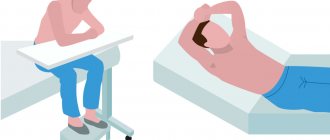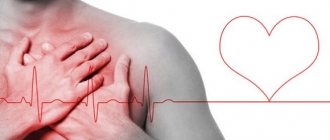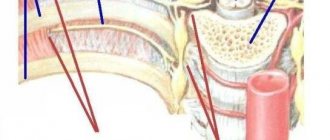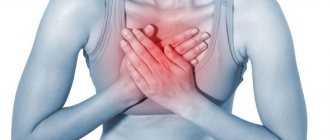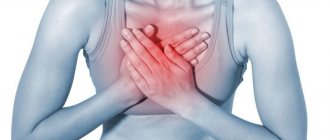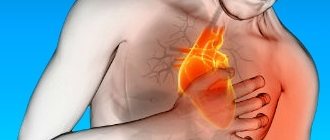Heart pain includes:
- Pain due to coronary heart disease (angina)
. The cause of these pains is oxygen “starvation” of the heart cells when the load on it increases. The lack of oxygen supply is caused by a narrowing of the vessels supplying the heart due to the deposition of fat-like accumulations (atherosclerotic plaques) on their walls, as a result of which they lose the ability to expand and provide blood flow adequate to the needs of the heart. Such pain, as a rule, occurs during physical exertion or psycho-emotional stress, has a pressing or squeezing nature, is often localized behind the sternum, less often in the left half of the chest, is relieved (stopped) by taking nitro drugs or when the load is stopped, and is short-term in nature (several minutes) . - Pain during myocardial infarction.
Their character is similar to the pain of angina pectoris, but they are usually longer lasting, may be accompanied by shortness of breath, cold sweat, and are not relieved by taking nitroglycerin. The cause of such pain is a blockage of one or more arteries supplying the heart by a blood clot (thrombus). - Pain similar to angina pectoris can
also occur in a number of other conditions characterized by an increased load on the heart muscle: for example, with a hypertensive crisis, heart defects (aortic stenosis), hypertrophic cardiomyopathy. In such cases, the cause of pain is overload of the heart with sufficient blood supply. - Cardialgia
is pain in the heart that is not associated with either ischemia or myocardial overload, but occurs in the presence of minimal structural changes in the heart, often congenital (additional chords of the left ventricle, mitral valve prolapse), or when the regulation of its activity through the nervous system is impaired ( vegetative-vascular dystonia).
A large group of causes of chest pain have nothing to do with the heart. In these cases, pain is provoked by damage to other organs. Let's list some of them:
- Osteochondrosis of the cervical and thoracic spine
is the cause of the so-called “vertebrogenic cardialgia,” which also has similarities with angina pectoris. The pain is intense and prolonged, can be localized behind the sternum and in the left half of the chest, and radiate to the left arm. However, unlike angina pectoris, pain in thoracic osteochondrosis is associated with changes in body position and intensifies when turning the head or moving the arms; - Gastroesophageal reflux disease (GERD).
Accompanied by heartburn - a burning sensation in the chest that occurs when acidic gastric juice enters the esophagus from the stomach. May be accompanied by a sour taste in the mouth and belching, most often occurs when bending over or in a lying position, and can be relieved by taking antacids (Almagel, Maalox); - Pleurisy.
In various diseases, but more often with pneumonia, inflammation occurs of the membrane lining the inside of the chest cavity and covering the lungs. This pain is acute, localized in one place, intensifies with breathing and coughing; - Tietze syndrome.
Pain in this condition occurs due to inflammation of the cartilage, most often in the places where it is attached to the sternum, and thus imitates an attack of angina. In such cases, palpation of the site of pain helps differentiate one condition from another - with Tietze syndrome, the inflamed cartilage is sharply painful, with angina pectoris - palpation does not affect the intensity of pain; - Chest pain
can be a consequence of muscle diseases. Such pains, as a rule, are provoked by turns of the torso, movements of the arms; - Bruises and fractures of the ribs
can also cause pain, sometimes very intense; - Diseases of the esophagus.
Pain can also occur with spasm of the esophagus, achalasia (a disease of the lower esophageal valve that interferes with the passage of food), and such pain goes away after the patient takes nitroglycerin, which relaxes the muscles of the esophagus, which makes it difficult to diagnose the condition; - Shingles.
It is a herpetic infection that affects the nerve endings and causes severe pain in the chest; - Diseases of the gallbladder and pancreas.
Gallstones or inflammation of the gallbladder (cholecystitis) and pancreas (pancreatitis) can cause pain in the epigastric region, radiating to the heart; - Pulmonary embolism.
This dangerous condition develops when a blood clot enters the pulmonary artery, through which blood flows to the lungs, blocking the flow of blood through the lungs to the heart. As a result, severe dull pain in the chest, shortness of breath appears, blood pressure drops sharply, and loss of consciousness is possible.
Pain of any nature and location in the chest, especially if it occurs for the first time, should alert a person and cause immediate consultation with a doctor. After which it is necessary to undergo all examinations prescribed by the doctor to determine the cause of the pain. It is most important to diagnose cardiac pathology as early as possible, since it is this pathology that is associated with the greatest risk to the patient’s life.
How to distinguish heart pain?
One of the signs of heart problems is pain. Diseases in which such symptoms are possible include: Angina pectoris. There is a feeling of discomfort or pain of a pressing, squeezing or burning nature. The pain radiates (transfers, spreads) to the left shoulder or the inside of the arm. A painful attack often begins against the background of physical activity or strong emotional impact. It can last up to 10 minutes and is relieved with nitroglycerin.
Aortic dissection . If at least one of the following symptoms appears, you should immediately (!) call an ambulance: sharp migrating pain, with possible irradiation to the area of the left arm or neck; burning, pressing or tearing pain; possible fainting; cyanosis (pallor) of the upper half of the body is observed; bradycardia (slow heart rate).
Myocardial infarction. Severe chest pain and fear of death are the most characteristic signs of a heart attack. In the peripheral form, the pain radiates to the neck, extends to the left limb and little finger. The following symptoms are typical for a heart attack: attack of suffocation, unproductive cough; the duration of pain is more than 15 minutes; pain does not go away after taking nitroglycerin; the pain intensifies with movement.
Myocarditis. With myocarditis, you may feel general malaise and persistent pain in the heart area. Myocarditis is an inflammatory process often accompanied by heart rhythm disturbances. Physical activity increases pain; Possible low-grade fever due to an infectious process.
Pulmonary embolism. Accompanied by symptoms such as: tachycardia (rapid heartbeat), shortness of breath, prolonged chest pain.
One of the most unpleasant types of pain is burning. The causes of burning pain are varied: it can be associated both with heart disease, the symptoms of which are described above, and with problems of the stomach and esophagus. The main cause of burning pain behind the sternum, not associated with the heart, may be: gastritis, pleurisy, esophagitis, intercostal neuralgia, gastric or duodenal ulcer. The main difference between such pains will be clear localization. Pain associated with the gastric tract is not relieved by nitroglycerin. But the main feature of cardiac burning pain behind the sternum will be its diffuse nature - it is difficult for the patient to show a specific location of its localization. In addition, this type of pain can radiate to the left arm and neck. Nitroglycerin will help determine heart disease: after taking it, the pain should go away or weaken. In the case of angina pectoris, nitroglycerin will help relieve pain completely, but in case of a heart attack - only slightly.
Discomfort and pain associated with breathing is a fairly common symptom. Pain when breathing is not always associated with the lungs. Similar pain can occur with: pulmonary embolism, intercostal neuralgia, pneumonia, pleurisy, ARVI, pneumothorax, advanced scoliosis, tuberculosis, lung abscess. For any of the above diagnoses, you should seek help from a doctor.
An ordinary one-time pain, or a stabbing pain associated with any action, is considered not so dangerous. It is worth understanding that stabbing pain is not typical for heart disease. Much more dangerous is pressing, squeezing or burning pain. But stabbing pain can mean serious problems with the lungs; it also occurs with thrombosis or embolism.
The first step is to understand what exactly led to the pain. Does it recur with physical activity? Does it occur when you assume a certain position? After this, try to find the place where the stabbing pain occurs. But you shouldn’t diagnose yourself and prescribe treatment on your own. If the pain recurs, consult a doctor.
Chest pain in an elderly person: what to do ? With age, the likelihood of developing various diseases increases. In an elderly person, pain may be associated with uncontrolled arterial hypertension, heart failure, arrhythmias, and chronic bronchitis. In addition to the reasons described above, chest pain can be caused by ischemia of the heart muscle. Coronary heart disease can manifest itself in an elderly person in the form of angina pectoris. In this case, the pain is associated with physical activity, even minor. It should be understood that the defense mechanisms of older people are reduced, so you should not hesitate or doubt when calling an ambulance.
What to do if you have chest pain? First of all, you should unfasten the top buttons of your clothing. If you have a heart disease previously diagnosed by a doctor, you must take the prescribed medications. If this happens for the first time, give the victim a nitroglycerin tablet (it is better to put it under the tongue). If there is no positive effect, repeat the dose after 5-10 minutes. If repeated use does not produce results, you must call an ambulance. Delay may cost the patient his life. If you don't have nitroglycerin on hand, you can put validol or mint gum under your tongue. Mint irritates the receptors located under the tongue, which reflexively relieves vascular spasm. Cases when it is necessary to quickly call an ambulance: pain of a squeezing, pressing nature; irradiation of pain to the left arm, neck, attack of pain is not relieved by nitroglycerin; long-term disturbances in pulse and blood pressure are observed; disturbance of consciousness.
Many people ignore these signals or interpret them incorrectly. Heart pain in different diseases has a different nature, and it is worth understanding that only a doctor can make an accurate diagnosis.
Remember! Excessive self-confidence and procrastination can lead to serious consequences for the patient.
Prepared by a doctor on medical prevention
Healthcare Institution "Slonim Central District Hospital" Vataev O.L.
What is important to the patient?
- pain behind the sternum and in the heart area can be a consequence of angina pectoris or myocardial infarction - conditions that directly threaten a person’s life;
- if chest pain occurs, it is necessary to seek medical help from qualified specialists as soon as possible, since delay in this situation can cost a person’s life;
- Only a cardiologist can decide on a cardiac or non-cardiac cause of chest pain after conducting the necessary examination;
- Treatment of patients with coronary heart disease should be carried out only in the cardiology department of the hospital, equipped with an intensive care ward.


